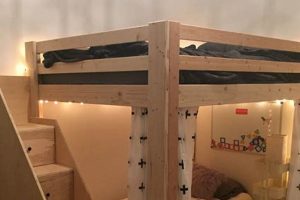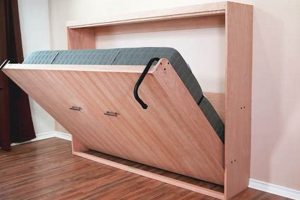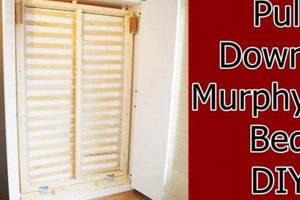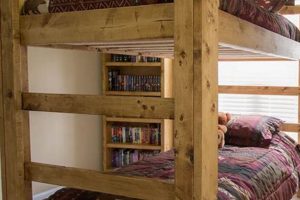A self-assembled outdoor lounging structure, often suspended from a porch or sturdy frame, designed to offer a relaxing seating or reclining experience. These constructions are typically built using readily available lumber, hardware, and cushioning materials, and tailored to individual aesthetic and size preferences. As an example, a platform designed to resemble a small bed, complete with a mattress and pillows, suspended by ropes or chains, constitutes such a project.
The appeal of creating such an outdoor feature lies in its combination of cost-effectiveness and customization. Compared to purchasing a pre-made product, constructing one allows for significant savings and the freedom to adapt dimensions, style, and materials to perfectly match a specific outdoor space and personal taste. Historically, swings have been a symbol of leisure and relaxation, and this approach to building one amplifies that association with the added satisfaction of personal creation.
The subsequent discussion will delve into the crucial aspects of planning and executing a safe and aesthetically pleasing project. Considerations will include structural integrity, material selection, suspension techniques, and design options for optimal comfort and visual appeal.
Essential Construction Guidelines
This section outlines crucial considerations for the successful and safe execution of such an outdoor furniture project. Adherence to these guidelines will enhance structural integrity, longevity, and user safety.
Tip 1: Prioritize Structural Integrity: Calculate load-bearing requirements and select lumber and hardware accordingly. Employ appropriate joinery techniques, such as mortise and tenon or reinforced screws, to ensure a robust frame.
Tip 2: Material Selection is Paramount: Opt for weather-resistant materials like treated lumber, cedar, or redwood. Consider using stainless steel or galvanized hardware to prevent rust and corrosion.
Tip 3: Suspension System Safety: Choose high-strength ropes, chains, or cables with a weight rating exceeding the expected load. Employ secure attachment points, such as reinforced eye bolts or heavy-duty hooks, anchored to a structurally sound support beam or frame.
Tip 4: Accurate Measurements are Crucial: Precise measurements are essential for a level and stable platform. Double-check dimensions before cutting materials to minimize errors and ensure proper alignment.
Tip 5: Secure Fastenings: Use appropriate fasteners, such as lag screws or through bolts, to securely attach the suspension system to the platform. Verify that all connections are tightened adequately and regularly inspected for wear.
Tip 6: Weight Distribution: Design the platform to distribute weight evenly across the support structure. This will minimize stress on individual components and prevent sagging or instability.
Tip 7: Consider Clearance: Calculate the required vertical and horizontal clearance to ensure safe swinging motion. The location need to accommodate comfortable swinging without risk of collisions.
By adhering to these guidelines, one can create a durable and safe outdoor lounging structure that will provide years of enjoyment.
The following section will explore design variations and customization options for this relaxing outdoor feature.
1. Planning
Effective planning is the foundational element of any successful outdoor lounging structure project. It dictates the structural integrity, aesthetic outcome, and ultimately, the safety and longevity of the final product. A comprehensive plan mitigates risks and ensures alignment between the builder’s vision and the realized structure.
- Dimensional Accuracy
Accurate measurements are paramount to ensuring the proper fit and function. Miscalculations can result in a structurally unsound framework, necessitating costly revisions. For example, incorrect width measurements can lead to an unstable or unusable seating area.
- Load Capacity Assessment
A thorough assessment of expected weight is critical for selecting appropriate materials and suspension hardware. Overlooking this aspect can lead to structural failure and potential injury. A plan should detail the maximum weight the structure is designed to support, with a safety margin incorporated.
- Spatial Considerations
Planning must encompass the intended location and available space. Adequate clearance from surrounding objects, such as walls or trees, is essential for safe swinging motion. Failure to account for spatial limitations can result in an unusable or hazardous installation.
- Material Procurement Strategy
A detailed materials list, including quantities and specifications, streamlines the procurement process and minimizes waste. Sourcing materials in advance prevents delays and ensures that necessary components are readily available throughout the construction process. Consider the need of marine-grade rope if you place this at the beach
The interconnectedness of these planning facets highlights the importance of a holistic approach. A well-defined plan not only minimizes construction challenges but also lays the groundwork for a durable and enjoyable outdoor feature. Therefore, dedication to thorough planning is not merely a preliminary step but an investment in the long-term value and safety of this backyard furniture.
2. Materials
The selection of appropriate materials is foundational to the creation of a safe, durable, and aesthetically pleasing outdoor lounging structure. The success of such a project hinges significantly on the characteristics of the chosen wood, hardware, and finishing products. The materials employed directly influence structural integrity, resistance to environmental factors, and overall longevity. For instance, untreated lumber is highly susceptible to rot and insect infestation, leading to premature failure, while pressure-treated lumber or naturally durable species like cedar offer enhanced resistance to these elements.
Consider the suspension system: Using inadequate rope or chain constitutes a severe safety risk. Marine-grade rope or heavy-duty chain, with appropriately rated weight capacity, are essential for secure suspension. Similarly, the choice of fasteners, such as screws or bolts, must align with the intended load and environmental conditions. Stainless steel hardware is recommended to prevent corrosion and maintain structural integrity over time. The selection of cushioning materials also contributes to the user experience. Outdoor-rated fabrics resist fading and moisture damage, while quick-drying foam prevents mildew growth and ensures comfort.
In summary, material selection dictates the safety, durability, and aesthetic appeal of the final product. A comprehensive understanding of material properties and their suitability for outdoor applications is paramount. Prioritizing quality materials and proper installation techniques is a critical investment that translates directly into the long-term value and enjoyment of this backyard furniture.
3. Suspension
The method of suspension is paramount to the safety, functionality, and aesthetic of a self-assembled outdoor lounging structure. It dictates weight distribution, swing motion, and overall structural integrity. The suspension system connects the platform to its support structure and must be engineered to withstand dynamic loads and environmental stresses.
- Attachment Point Security
Secure attachment points are crucial for preventing catastrophic failure. These points, whether eye bolts, hooks, or other hardware, must be appropriately rated for the intended load and firmly anchored to a structurally sound support beam or frame. The consequences of inadequate attachment points include sudden detachment and potential injury.
- Rope and Chain Selection
The materials used for suspension, typically rope or chain, must possess sufficient tensile strength and resistance to weathering. Marine-grade rope, designed for maritime applications, offers superior UV resistance and durability compared to standard rope. Similarly, heavy-duty chains with a high working load limit provide reliable support, but require regular inspection for wear and corrosion.
- Weight Distribution and Balance
Even weight distribution across the suspension points is essential for a stable and comfortable swing. Uneven weight distribution can lead to tilting, instability, and increased stress on individual suspension components. Careful planning and precise measurements are necessary to ensure proper balance.
- Swing Mechanics and Clearance
The suspension system influences the swing motion and requires consideration of surrounding clearance. The length and angle of the suspension components affect the arc and range of motion. Adequate clearance from obstructions, such as walls or trees, is crucial for safe and unrestricted swinging.
The success of constructing a self-assembled outdoor lounging structure relies heavily on the proper design and implementation of its suspension system. Prioritizing safety, using high-quality materials, and adhering to sound engineering principles ensures a reliable and enjoyable outdoor feature. Neglecting these aspects can lead to structural failure and potential harm.
4. Comfort
The element of comfort is central to the intended function and overall appeal of a self-assembled outdoor lounging structure. It directly impacts the user experience, influencing the extent to which the structure fulfills its purpose as a space for relaxation and leisure. A design that neglects comfort considerations undermines the very essence of the project.
- Mattress Selection and Support
The choice of mattress is paramount for ensuring adequate support and cushioning. A high-quality mattress, designed for outdoor use, provides a comfortable surface for lounging and resting. Inadequate mattress selection can lead to discomfort, back pain, and a diminished user experience. Considerations should include mattress thickness, density, and resistance to moisture and mildew.
- Cushioning and Padding Materials
Supplementary cushions and padding enhance comfort by providing additional support and softness. The selection of appropriate materials is crucial for resisting wear and tear from outdoor exposure. Fabrics should be UV-resistant and water-repellent, while fillings should be quick-drying to prevent moisture accumulation. The strategic placement of cushions can optimize ergonomic support and promote relaxation.
- Ergonomic Design Considerations
Ergonomics play a significant role in comfort by promoting proper posture and reducing strain. The dimensions and angles of the lounging platform should be carefully considered to accommodate various body types and seating positions. Features such as armrests, backrests, and adjustable supports can further enhance ergonomic comfort. Attention to these details minimizes discomfort and encourages prolonged use.
- Environmental Factors and Mitigation
Comfort is also influenced by environmental factors such as sunlight, temperature, and insects. Providing shade through awnings, canopies, or strategically placed landscaping can mitigate the effects of direct sunlight and heat. Insect netting or repellent solutions can minimize insect bites and create a more enjoyable outdoor experience. Consideration of these factors can significantly enhance the overall comfort and usability of the structure.
Integrating these comfort facets into the design and construction of a self-assembled outdoor lounging structure elevates the user experience and ensures its effectiveness as a relaxing and inviting outdoor retreat. The careful selection of materials, attention to ergonomic principles, and mitigation of environmental factors contribute to a space that encourages relaxation and provides lasting enjoyment.
5. Aesthetics
The visual appeal significantly influences the overall value and satisfaction derived from a self-assembled outdoor lounging structure. Aesthetics directly impact how the structure integrates into its surroundings, contributing to or detracting from the ambiance of the outdoor space. A well-designed structure enhances the visual appeal of a patio or garden, while a poorly designed one can appear incongruous and uninviting. For example, a platform crafted from reclaimed wood and finished with natural stains complements a rustic garden setting, while one built from brightly colored plastic might be more appropriate for a modern, minimalist space. This aspect extends beyond mere appearance; it encompasses the structure’s ability to create a desired atmosphere.
Customization offers a pathway to aligning the structure’s appearance with individual preferences and the existing landscape. Paint colors, fabric choices, and decorative elements allow for personalization. Integrating features such as string lights, throw pillows, and potted plants can further enhance visual appeal and create a more inviting atmosphere. For instance, incorporating nautical-themed elements, such as rope details and blue and white fabrics, can complement a coastal setting. Conversely, using vibrant colors and geometric patterns can lend a contemporary feel to a modern patio. The choice of suspension hardware, such as decorative chains or natural fiber ropes, also contributes to the overall aesthetic.
Ultimately, prioritizing aesthetics in the design and construction process is an investment in creating a visually pleasing and harmonious outdoor living space. The ability to tailor the appearance of a self-assembled lounging structure allows for a seamless integration with the surrounding environment, enhancing the overall enjoyment and value of the outdoor space. While structural integrity and comfort remain paramount, the consideration of aesthetics ensures that the structure serves not only as a functional piece of furniture but also as a visually appealing element that contributes to the overall ambiance of the outdoor environment.
6. Safety
The safety of a self-assembled outdoor lounging structure demands rigorous attention to detail throughout the planning, construction, and usage phases. Overlooking safety considerations can result in structural failure, personal injury, or property damage. The inherent risks associated with suspended structures necessitate a proactive approach to risk mitigation.
- Load Capacity Adherence
Exceeding the specified weight limit poses a significant safety hazard. This involves considering the combined weight of the structure itself, the maximum number of occupants, and any additional accessories. Overloading the structure can lead to catastrophic failure of the suspension system or the frame itself, resulting in falls and potential injuries. Clear weight limit signage and enforcement of occupancy restrictions are essential preventative measures.
- Structural Integrity Verification
Regular inspection and maintenance of all structural components are crucial for identifying and addressing potential weaknesses. This includes checking for signs of rot, corrosion, or damage to the wood, hardware, and suspension system. Prompt repair or replacement of compromised components prevents further deterioration and minimizes the risk of structural failure. A proactive maintenance schedule, including periodic tightening of fasteners and application of protective coatings, extends the lifespan and ensures the continued safety of the structure.
- Suspension System Security
The integrity of the suspension system is paramount for ensuring the stability and safety of the structure. This involves verifying the secure attachment of ropes, chains, or cables to both the platform and the support structure. Regular inspection of suspension components for wear, fraying, or corrosion is essential. Utilizing appropriate knot-tying techniques or hardware designed for load-bearing applications ensures a reliable and secure connection. Furthermore, proper tensioning and balancing of the suspension system are crucial for preventing tilting or instability.
- Clearance and Swing Path Management
Maintaining adequate clearance around the structure prevents collisions and potential injuries during swinging motion. This requires ensuring sufficient horizontal and vertical space, free from obstructions such as walls, trees, or furniture. Defining a clear swing path and educating users about safe operating procedures minimizes the risk of accidental impact. Furthermore, installing soft landing surfaces, such as mulch or rubber padding, can mitigate the severity of falls.
The aspects detailed are not exhaustive, but emphasize the critical importance of safety considerations in every phase of the self-assembled outdoor lounging structure process. A comprehensive safety protocol, encompassing diligent planning, meticulous construction, and proactive maintenance, ensures a secure and enjoyable experience. The risks associated with suspended structures demand a commitment to prioritizing safety above all else.
Frequently Asked Questions
The following addresses common inquiries regarding the construction, safety, and maintenance of such structures. These responses aim to provide clarity and guidance based on accepted best practices and engineering principles.
Question 1: What factors determine the weight capacity of a self-assembled outdoor lounging structure?
Weight capacity is determined by the material strength of the lumber, the type and spacing of fasteners, and the load-bearing capacity of the suspension system. A structural engineer or experienced builder can provide accurate calculations based on specific design parameters.
Question 2: What wood species are most suitable for outdoor use?
Naturally decay-resistant species like cedar, redwood, and cypress are excellent choices. Pressure-treated lumber also offers protection against rot and insect infestation. The selection should consider both durability and aesthetic preferences.
Question 3: How often should the suspension system be inspected?
The suspension system should be inspected at least twice annually, preferably at the beginning and end of the outdoor season. Examine ropes for fraying, chains for corrosion, and hardware for signs of wear or loosening.
Question 4: What are the recommended safety precautions during construction?
Appropriate personal protective equipment, including eye protection, gloves, and respiratory masks, should be worn. Adherence to safe woodworking practices, such as using sharp tools and securing workpieces, is essential. Consult relevant building codes and regulations.
Question 5: What is the best way to protect the wood from the elements?
Applying a high-quality exterior wood sealant or stain provides protection against moisture, UV radiation, and temperature fluctuations. Regular reapplication, as recommended by the manufacturer, is necessary to maintain optimal protection.
Question 6: How can swinging motion be minimized to enhance stability?
Employing a shorter suspension length reduces the arc of the swing. Strategically placed stabilizing ropes or chains, anchored to the ground or nearby structures, can further minimize unwanted motion.
The information presented serves as a general guideline and does not substitute for professional advice. Proper planning, material selection, and construction techniques are crucial for ensuring the safety and longevity of the structure.
The subsequent section will delve into innovative design concepts and advanced construction techniques for such outdoor features.
Conclusion
The preceding exploration of the diy bed swing concept has elucidated the multifaceted aspects involved in its creation. The necessity of meticulous planning, careful material selection, secure suspension methods, ergonomic comfort considerations, aesthetic integration, and unwavering adherence to safety protocols have been thoroughly examined. These elements collectively contribute to the structural integrity, user experience, and overall success of such a project.
The construction of a “diy bed swing” represents a significant undertaking that demands both technical proficiency and a commitment to responsible building practices. Prospective constructors are encouraged to approach this endeavor with diligence, prioritizing safety and adhering to established guidelines. The realization of a durable, aesthetically pleasing, and safe outdoor lounging structure requires a synthesis of knowledge, skill, and unwavering attention to detail. The rewards of such an endeavor are a testament to human ingenuity and the enduring appeal of self-sufficiency.







